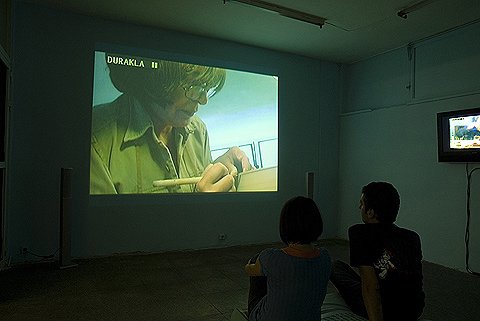Istanbul Foundation for Culture and Arts,
Sep 08, 2007 - Oct 04, 2007
Beyoglu, Istanbul, Turkey
10th Istanbul Biennial Review
by Matthew Schum
Ursula BiemannÕs The Black Sea Files video installation claims to be a portrait of the Caspian oil pipeline stretching from Azerbaijan to the eastern Mediterranean in Turkey. What we see in fact is everything peripheral to a major petrol-pumping artery brought to life in what she calls geobodies. The devastating wake of oil development is predictable but captivating due to the artistÕs visual language: the editing weaves together first person testimony and the off the map landscape seamlessly. Turmoil, polluted lands, and corrupt black markets, such as prostitution and human trafficking that she sees coinciding with massive infrastructural development comes through in the balance of two things: earthly silence and human proof. The Black Sea Files amounts to a kind of amplified reportage that many artists reach for but miss. Though documentary at heart, the video is aesthetically driven. Her filmic touch allows characters removed from their own witness to drive the cyclical narrative. Unlike other artists, Biemann refrains from instrumentalizing subjects as mere containers of injustice in a political saga.
Also abiding a kind of neo-realism is Istanbuler Omer Ali KazmaÕs masterful tribute to human labor. Five videos capture, respectively, a brain surgery clinic, a clock masterÕs shop, a potterÕs studio, a steel mill, and a slaughterhouse. KazmaÕs elliptical installationÑwhat he calls a ÔfamilyÕÑseemed deserving of the Palme dÕOr in the video heavy biennial.
Entering KazmaÕs blackbox, one is immediately drawn to the grisly scenes from the slaughterhouse. Surely harvesting animals is a cruel business. Yet the expectation of this did not seem to change what is at stake for the artist (or this viewer): morbid curiosity and the visualization of methodical killing. If one didnÕt know, squeals and spilled fluids continue to erupt from livestock long after they are hung to die. Like any horror film, Slaughterhouse intertwines vision with the anticipation of catastrophe. And the plot is simple: each victim awaits dismemberment on an unyielding assembly line. The video exhibit a disciplined resistance to sympathy, yet it nonetheless takes shelter in the mechanism of record: like the saws, pinchers, and industrial skin-peelers used by factory workers to break each animal apart, the camera functions systemically within each shot. It is a tool with a designated purpose that becomes another integrated instrument providing a minimum distance in the transformative process from creature to meat.
This sinister gaze was more deeply hidden than I first realized in an ambient rhythm between videos. Other noises of work and concentration that filled each channel slowly came into view. Appropriately titled, the Obstructions pulled the viewer in with pathos only to negate that within a dispersed spectrum of labor. I realized the barbarous packing plant was a decoy dissembling a metronomic pulse. Once attention shifted from horror to other forms of emotion revealed in each specialized activity, an individuated field simultaneously emerged. The task of the butchers blended with the others, and KazmaÕs discretely partitioned ensemble became a meditation more real than death, on the human capacity to manipulate reality, infinitely, regardless of material or structure.
If the 10th Istanbul Biennial itself sought to contain a system of transformation it was perhaps inhibited by pursuing globalization as a grand scope, which IstanbulÕs own self-indulgence promotes. In reality, the world never seemed more potent and humanly interconnected than in the modest self-contained gesture of the Obstructions. Omer Ali Kazma describes each video in his media democracy beautifully: ÒNone of them lie, hide the ugly bits or distort the truth for comfort as commodified fantasy does. As individual videos, they might negate so that as a group, they can affirm from a higher position.Ó
This gets to heart of the issue with Not Only Possible, But Also Necessary: Optimism in the Age of Global War, and the unlikely idea of optimism in the age of global war. The exhibition placed urban renewal at the core of global strife without burdening itself with a role that went beyond observation. How to actively participate in what a biennial ponders is always a dilemma, yet, unlike 2005Õs Istanbul, any effort to understand the institutional role (read critique) the biennial itself continues to play in the transformation of Istanbul (as city and image) was clearly missing (avoided?). Without being touristic, as various Istanbul Biennials have been, this exhibition nonetheless came off as a depoliticized affair in terms of the use of spaces and the elaboration of political ideas through artworks. It never quite got around to considering how the biennial (or contemporary art for that matter) can be used as a totally separate instrument nonetheless tracking parallel to modern forms of development and disassembly. This biennial brought attention to this violence, more or less to frame it without picking it apart.
Matthew Schum is pursuing his PhD at the University of California San Diego, department of Visual Arts. His recent research has explored the experience of contemporary art in urban exhibitions.
|











